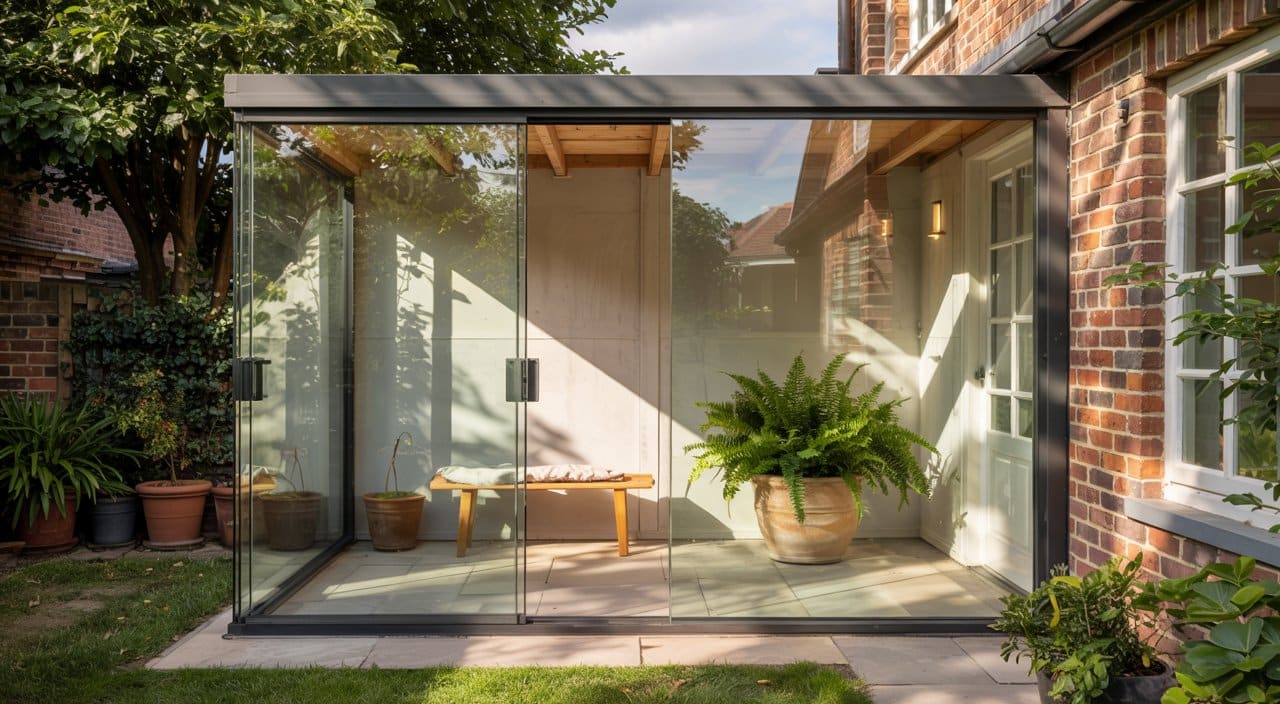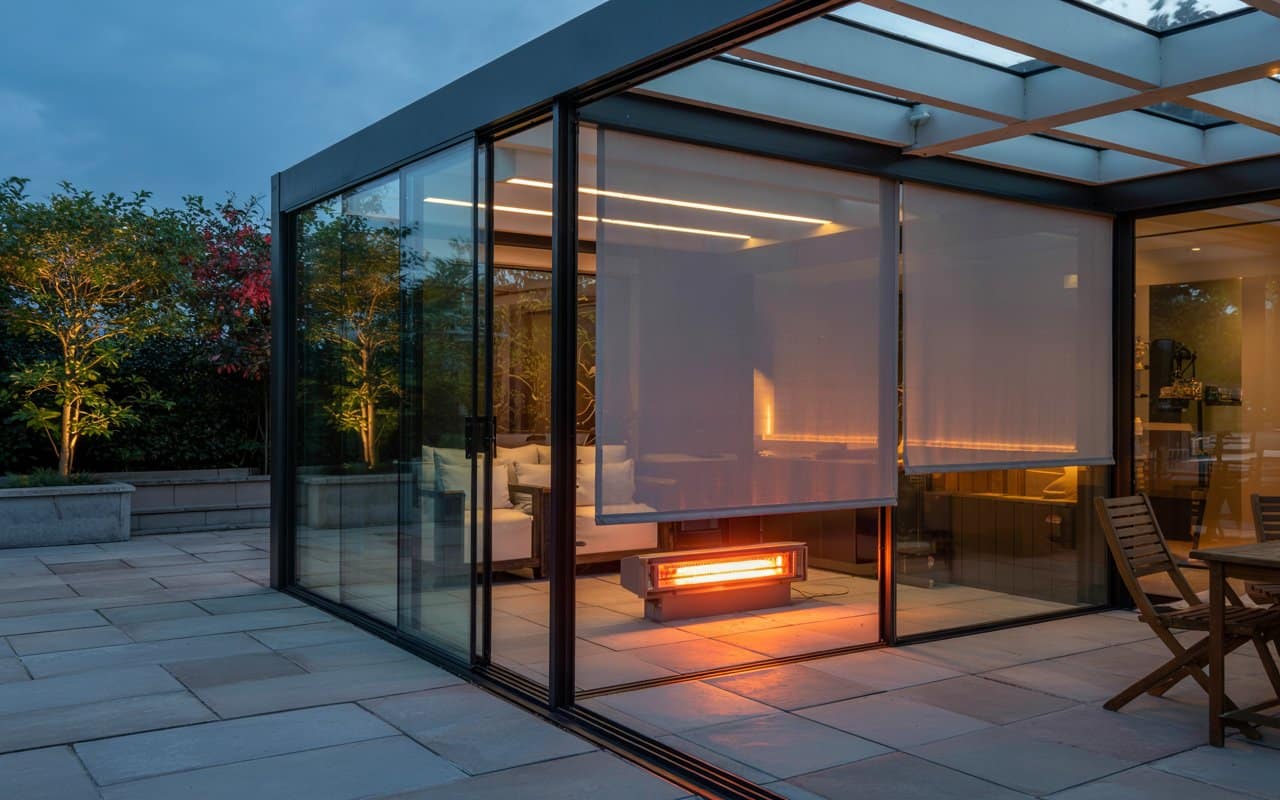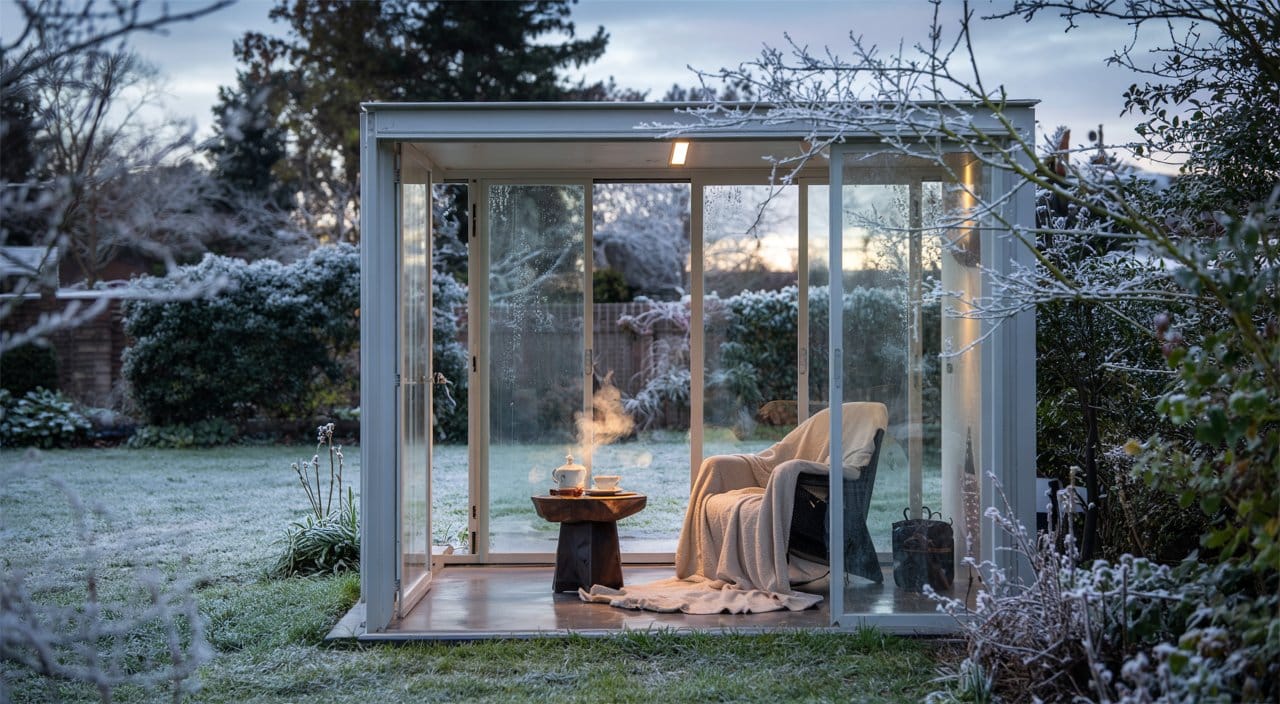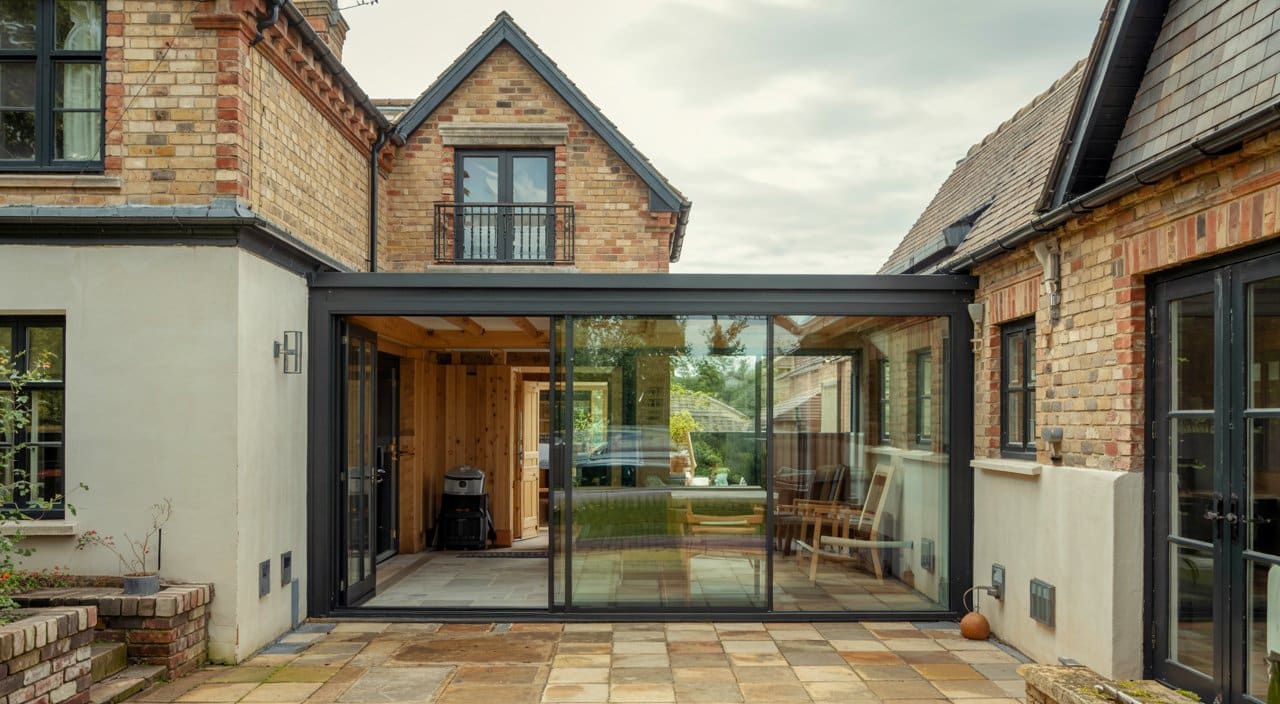What Sets Glassrooms and Conservatories Apart for Modern Living?
The Anatomy of Disappointment and the Logic of Upgrade
A room, flooded with light for a handful of hours, then abandoned when temperatures veer off course. This cycle defines much of the British extension legacy—homeowners imagining sun-washed breakfasts or tranquil Sunday reading, only to return to a room marooned between seasons and moods. Most conservatories exist in this gap between intention and outcome. Rigid frames, misty polycarbonate, and persistent condensation are not minor flaws; they reveal architectural miscalculations embedded in the fabric of yesterday’s solutions.
“We thought more space meant more freedom, but it became the part of our home we rarely entered.”
Engineering Belief: Glassrooms as Fluent Space
The glassroom, by contrast, represents a philosophical leap—space no longer added but restored. The boundaries between indoors and out dissolve; temperature and light are orchestrated, not suffered. Our projects, designed around frameless integration and engineered glass, are an answer to years of homeowner advocacy for rooms that work—not just exist. Every panel speaks to an unspoken aspiration: that comfort and style should never feel at odds.
The Misconception of “Extra Room”
Homeowners often begin with the idea that any additional enclosed space is a win. The reality we see time and again is the erosion of novelty: glare at noon, chill at dusk, a white elephant of insurance and upkeep. Glassrooms reverse this decline. The seamlessness of aluminium, the performance of architectural-grade glass, and the invisibility of joinery give our installations the appearance—and reality—of belonging. In practice, that means year-round functionality, lasting curb appeal, and experiences that adapt as your needs evolve. Our mission is not to add square footage but to amplify living possibilities.
How Does Architectural Design Control Daylight and Garden Connection?
Light, Architecture, and the Emotional Climate of Your Home
The promise of “flooded with daylight” is seductive—until the physical reality of frames, roof beams, and filtering plastics turn a glass extension into a mosaic of stray sunbeams and shadow pockets. Homeowners describe it as a kind of betrayal: the room never truly opens to the garden or the sky, settling for half-light and half-use. Our experiential maps of client usage confirm this: rooms designed for a view frequently block it, and clever layouts are undone by technical limitations.
“Afternoons used to mean pulling down blinds—now, we enjoy the whole evening as if we’re outside.”
The Glass-to-Frame Revolution
Where conservatories rely on segmented panels interrupted by support structures, glassrooms take a different path. Every specification—from the width of sliding panels to the transmission index (g-value)—is calibrated to maximise usable daylight. Opting for frameless multi-track doors, we prioritise not only maximal light but directional control: light that glances across a breakfast bar in midwinter or infuses a garden dinner with warmth long after dusk.
Technical Table: Daylight Life-Cycle Comparison
| Criterion | Conservatory | Glassroom (Frameless) |
|---|---|---|
| Glass-to-Frame Ratio | 55–70% | 85–95% |
| Light Transmission (g-value) | 0.55–0.68 | 0.82–0.87 |
| Seasonal Glare | Frequent (roof angle) | Rare (engineered pitch) |
| Sightline Interruptions | High (bars, frames) | Minimal (frameless, panoramic) |
| Garden-to-Home Visual Flow | Disrupted | Seamless |
Daylight as a Lifestyle Engine
Clients report unanticipated results once a glassroom is installed. Meal times shift; evening routines extend beyond the traditional walls; garden vistas become daily features, not rare luxuries. This is not accidental. Every technical cue—panel join, corner post, reflective coating—is an invitation back to sunlight and landscape. The outcomes transcend extra square footage; they foster emotional connection, pride, and a new fluidity between indoors and out.
Why Is Year-Round Comfort About More Than Just Windows and Walls?
The False Choice: More Room or More Comfort?
Choosing between usability and beauty has defined decades of home improvement. Seasonal failure—freezing in February, stifling at summer’s peak—becomes the norm, with rooms either ignored or awkwardly climate-hacked by space heaters and fans. Homeowners learn to live around their investment, not within it.
“We dreamed of winter breakfast with blue sky—but the cold always won.”
U-Values, Passive Solar Gain, and Comfort on Demand
Glassroom engineering rewrites the comfort playbook. Performance glass, low U-value walls, and strategic roof pitch turn transient comfort into a lasting state. Rather than retrofitting blinds or unsightly plug-in heaters, our systems integrate hidden climate adjustments—double or triple glazing, infrared heating, ventilated eaves—specific to your property and preferences. The architecture responds to the day’s mood: on a sunny winter morning, solar gain ensures warmth; on summer’s brightest days, integrated shades and automated ventilation maintain cool flow.
Comfort Features Checklist
- Triple or double-glazed wall and roof panels for precise thermal control
- Low-E coatings to reflect heat when it’s unwanted
- Modular roof vents and retractable shades for airflow management
- Optional underfloor heating or discrete infrared emitters
Customization to Lifestyle, Not Just Specs
Comfort is not an abstract technical metric; it’s whether your favourite chair finds daily use, whether holidays include family in the garden, or whether you remember which months are off limits to your new space. The right glassroom is as personal as it is technical—a lived solution, unique to your rhythm, not a catalogue compromise.
What Maintenance, Longevity, and Support Distinctions Should Guide Decision-Making?
The Hidden Bill of “Hassle Costs”
Ask any long-term conservatory owner about maintenance, and a storey unfolds: frames that warp, seals that split, glass that smears or clouds faster than expected. These tasks are rarely calculated into the price but accumulate—draining weekends, requiring repeated professional intervention, eroding initial satisfaction.
“Maintenance started small, then became a regular battle against leaks and decay.”
Self-Sustaining Performance Through Design
Our glassrooms invert the typical maintenance profile by design. With powder-coated aluminium, self-cleaning glass, and advanced gasket systems, routine cleaning is transformed into a light, infrequent intervention. The resilience of top-tier materials ensures UV, wind, and moisture cannot easily corrupt performance or appearance. Clients who used to dread rain now welcome it as a natural rinse.
Longevity and Warranty Table
| Feature | Legacy Conservatory | Contemporary Glassroom |
|---|---|---|
| Frame Material | PVC/Aluminium Blend | Premium Powder-Coat Aluminium |
| Roof Material | Polycarbonate/Plastic | Laminated Glass |
| Average Lifespan | 10–15 years | 20–30+ years |
| Maintenance Frequency | Monthly/Quarterly | Seasonal/As Needed |
| Typical Aftercare | Optional, Ad hoc | Comprehensive, Scheduled |
| Warranty Terms | 1–5 years, limited | 10–20 years, robust |
Assurance by Partnership
Proper installation and lifelong support are what transform a premium structure into a winning investment. Our support doesn’t fade after keys are handed over. With transparent warranty and ongoing aftercare, the reassurance is the guarantee; you’re never left troubleshooting a leaking roof or brittle hinge. While the market is awash with “low price” offers, the real cost, measured in wasted time and edge-of-the-seat worry, favours enduring systems and responsive partners.
Where Do Planning Permission, Compliance, and Project Timelines Diverge?
The Bureaucratic Challenge: Extension as Obstacle Course
Stories abound from homeowners trapped by planning permission, building control snafus, and weeks that stretch into months of “pending” notice boards and incomplete rooms. Where a conservatory triggers local government paperwork, glassroom projects—properly specified—can frequently bypass such hurdles under permitted development.
“Planning delays stretched our build for months; we wanted more living, not more paperwork.”
Fast-Track Construction, Fewer Surprises
Our glassrooms are systematically engineered to streamline project delivery. By adhering to contemporary development guidelines, optimising prefabrication, and leveraging established supplier relationships, timelines contract to the necessary minimum. From first on-site assessment to final glass cleaning, milestones are tracked, and key moments—foundation checks, custom component delivery, final walkthrough—are coordinated to limit disruption. Complexity is never an adversary; it’s orchestrated from the first meeting.
Compliance Table
| Requirement | Conservatory | Glassroom |
|---|---|---|
| Planning Permission | Often Required | Often Exempt |
| Building Regulation Need | High | Low/Medium |
| Pre-Instal Timeline | 3–9 weeks | 2–5 weeks |
| Site Disruption | Frequent | Minimal |
| Approvals + Signoff | Manual | Streamlined |
Disruption Is Optional By Design
No one chooses an outdoor room for the joy of phone calls to local authorities, nor the clatter of scaffolding on a tranquil Sunday. By investing in a design-driven, code-compliant glassroom, you control the process, not the other way around. The Outdoor Living Group manages project momentum and compliance—not as a task but as a service ethos—ensuring the only “deadline anxiety” is the excitement of that first garden breakfast.
How Do Cost, Investment Value, and Resale Prospects Compare?
Price or Payoff: Rethinking the Real Investment
The sticker shock of home improvement is as much emotional as financial. Many buyers hesitate, chasing the lowest quote, then experience the slow drip of hidden costs and rapid depreciation as trends or regulations shift around their chosen extension.
“Paying less at the start meant paying more to fix everything later.”
True Value Beyond the Invoice
Our pricing is not a race to the bottom; it’s a clear map from investment to lifestyle reward. Glassrooms, with tested durability and innovation baked in, consistently outperform prior options on both property value and owner satisfaction. The uplift in curb appeal and functional space is compounded by reduced maintenance, lower energy costs (thanks to passive climate engineering), and the intangible asset of time recaptured from cleaning and troubleshooting.
Return-On-Investment Table
| Factor | Standard Conservatory | Frameless Glassroom |
|---|---|---|
| Average Project Cost | £15,000–£22,000 | £20,000–£35,000+ |
| Annual Maintenance | £350–£600 | £70–£180 |
| Property Value Impact | 2–5% uplift | 5–12% uplift |
| Energy Efficiency | Low–Medium | High (passive & adaptive) |
| Likelihood of Major Retrofit/Repair | High | Low |
The Market’s Verdict
Estate agents and surveyors now consistently rate contemporary glass rooms as a greater draw for buyers, elevating marketability and helping homes stand out in a crowded field of tired conservatories. Unlike dated add-ons, well-crafted glassrooms signal intention and taste, not simply square footage.
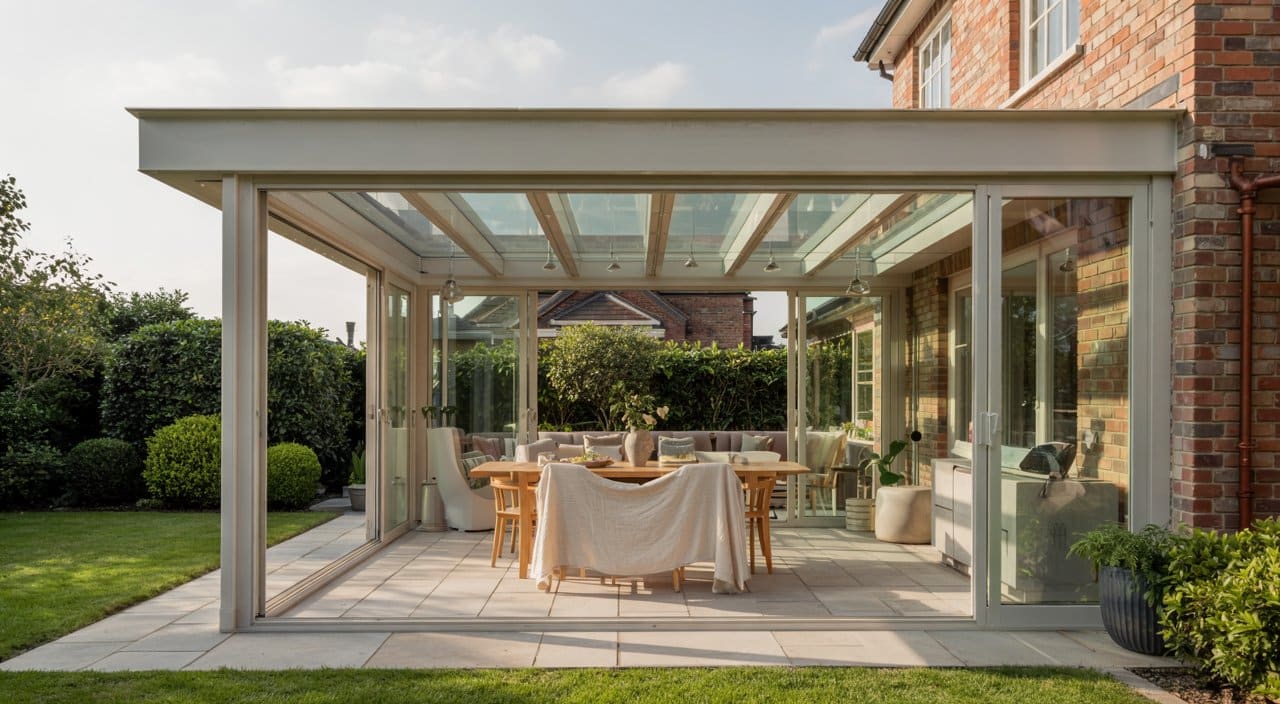
Can Sustainability, Adaptability, and Environmental Impact Influence the Best Choice?
Beyond the Greenwash: What Sustainability Truly Means
Every brochure claims sustainability, every installer nods at environmental “awareness,” but real-world impact is measured by materials, lifecycle, and adaptability. Legacy conservatories with PVC, composites, or polycarbonate not only underperform; they age into landfill. The expectation now: living spaces that support ecological health and do so transparently.
“Knowing our room was future-proofed made the decision feel right, not rushed.”
Environmental Engineering, Lifetime Results
We specify powder-coated, recyclable aluminium for frames, laminated glass with superior solar management, and avoid composites that shed microplastics or yellow. Each project is future-ready: modular, demountable, endlessly reconfigurable. Retrofit paths—adding a smart awning, extending a sidewall—require no brute force or waste.
Sustainability Features List
- Full-frame, recyclable aluminium and glass
- Low-E and solar-control glass for reduced year-round energy use
- Modular, reconfigurable structures for changing family or business needs
- Sourcing from manufacturers with demonstrable ISO and supply chain certifications
Adaptation as a Feature, Not a Project
Long-term value comes from the capacity to evolve, not the prison of sunk cost. Our clients integrate home offices, gyms, winter gardens with minimal disruption, supported by our product’s underlying flexibility. Sustainability is not just rhetoric; it is the foundation of enduring quality and peace of mind.
What Customization and Upgrade Paths Exist After Initial Installation?
The Structure That Grows With You
A room built “for now” risks feeling obsolete before your needs have even changed. Many homeowners and professionals have been burned—limited by the inflexibility of their original conservatory build when life stage or design taste shifts. True modern outdoor rooms begin with modularity, enabling seamless upgrades, extensions, and style evolution.
“We added a heated side screen for winter—it was like gaining another room overnight.”
The Adaptation Arsenal: Options at Your Fingertips
The beauty of a premium glassroom, especially those specified by The Outdoor Living Group, resides in its anticipated flexibility:
- Retrofittable side and roof awnings for weather or privacy
- Climate integrations (heating, ventilation, advanced glazing upgrades)
- Lighting enhancements (dimmable LEDs, colour-select mood lighting)
- Acoustic glass or sound-muting upgrades for city or roadside gardens
- Compatible security additions and home automation tie-ins
No Surprises, Only Potential
Unlike legacy extensions—where simple alterations become complex or even structurally unfeasible—our glassrooms are designed for anticipation. Every module is a potential springboard: from seasonal extras to lifestyle reimagination, the upgrade path is lateral, not vertical. That means you adapt, not just react, whenever life presents new requirements or visions.
Frequently Asked Questions
In What Ways Do Glassrooms and Conservatories Affect Home Value and Market Appeal?
The Real-World Test: Lasting Equity or Aesthetic Stagnation?
Resale anecdotes and survey data converge: property buyers now search not only for space, but for usable, light-filled, sustainable space. Extensions that feel temporary or require immediate updates become bargaining chips—deflating offers and extending time on the market.
“Valuers walked into the room and just nodded—there was nothing to fix or ‘update.’”
The Equity Equation: More Than Just Space
Well-integrated glassrooms generate outsized returns—not just in pound notes, but in buyer sentiment and neighbourhood perception. Home buyers tour extensions not just for volume, but to envision possibility waiting. The clarity of construction, the transparency of maintenance, and the environmental value edge an owner’s position handsomely above homes with only basic conservatories.
Market Impact Table
| Metric | Old Conservatory | Modern Glassroom |
|---|---|---|
| Median Buyer Uplift | £5,000–£12,500 | £15,000–£35,000+ |
| Viewing-to-Offer Ratio | 1:5 | 1:3 |
| Typical Renovation Ask | £3,000+ | <£1,000 |
| Energy Certificate Gain | C->C+ | C->B |
Visual and Emotional Leverage
It’s about the impression at the threshold, yes, but also the certainty that the room will last: it isn’t just “nice-to-have”—it’s “essential-to-keep.” Pride of ownership invisible in a listing, but instantly felt at a viewing. For those seeking not only liquidity but a signature move, the glassroom signals arrival and forethought.
Why Do Planning, Regulations, and Installation Complexity Shape Timelines?
Short Path to Satisfaction
Client journeys are rarely linear—especially when municipal guidelines, neighbour consultations, or engineering surprises arise. Among the prime regrets for conservatory owners: project slowdowns, last-minute inspections, and “grey area” compliance that only reveals itself long after the builders leave.
“What started as three weeks took all summer—we never saw a simple timeline.”
The Efficiency Blueprint
We anticipate regulatory inflexion points before ground is broken. By coordinating closely with local authorities, operating within compliance envelopes, and specifying modular builds with fewer wet trades, we strip out unknowns from the start. Every glassroom we manage is plotted on a timeline with margin, not hope, for each phase.
Timeline Milestones Table
| Stage | Conservatory | Glassroom (Design-Led) |
|---|---|---|
| Site Survey | 2 weeks | 1 week |
| Planning Submission | 3–6 weeks | 1–2 weeks, if needed |
| Delivery & Prep | 2–4 weeks | 1–2 weeks |
| Build/Instal | 4–8 weeks | 1–3 weeks |
| Total Project Duration | 10–20 weeks | 4–7 weeks |
Control Through Clarity
With proactive communication and a no-secrets approach, project risks are minimised. Installation goes from chaos to choreography, reflecting intention, organisation, and the safety net of proven expertise. Projects finish not only on time, but with a sense of genuine momentum.
Who Can You Trust for a Seamless, Risk-Free Glassroom or Extension Project?
The Identity Shift: From Consumer to Confidant
After decades of listening to homeowners, architects, and commercial visionaries, we recognise one truth: trust is less about paperwork than continuous experience. A client seeking certainty wants assurance—not abstract “warranties,” but lived evidence that everything works from the start and for years ahead.
“It’s strange—now when friends visit, we tell them who to call, not what to fix.”
The Outdoor Living Group: Your Partner in Lasting Comfort
We do not build and walk away. Our approach integrates initial vision with multi-stage follow-up, lifecycle care, and “always-on” expertise. Each detail—glass specification, site survey, finishing edge—is planned for delight as much as for durability. Reviews and testimonials stack, but our favourite trust signals are the impromptu gallery shots and winter-morning texts from clients still using and loving their outdoor transformation.
Committing to a glassroom or new outdoor space isn’t a leap of faith but an act of care for you and your property. The outcome: visible value, lasting comfort, and new rituals that begin where your former extension ended, powered by installation, materials, and ongoing partnership that are never left to chance.
Where Do Planning, Regulatory, and Build Timelines Become Make-or-Break Factors?
Unseen Barriers: When Red Tape Outpaces Construction
Optimism at the start of a home project fades fast when bureaucracy finds its way to your kitchen table. Planning permission—those infamous initials—can shift your vision from a summer reveal to a season lost in documents. Each missed detail, from glazed area ratios to eaves overhangs, risks a compliance setback or timeline collapse. Many homeowners expect the build itself to be the hard part. Instead, the slow churn of forms, inspections, and regulatory blind spots is what saps momentum and dims anticipation.
“Bureaucracy didn’t just delay our build—it took the enjoyment out of the process.”
Fast-Tracking Success by Exploiting the Regulations
Our glassrooms, specified with an eye for permitted development, ride the boundary of what is legally streamlined. The right choices on location, size, and drainage let your dream take form without the weight of a planning application. By contrast, traditional conservatories often breach thresholds that trigger extra scrutiny: too close to a boundary, too tall, too much glass. What reads as a simple upgrade in a brochure quickly morphs into months of limbo once paperwork starts circulating.
Realistic Timeline Mapping
Every phase of your build relates to a unique set of pacing variables:
- Site Survey and Feasibility: 1–2 weeks, longer on complex plots.
- Planning or Permitted Development Checks: Zero to 8+ weeks, determined by design compliance.
- Materials Scheduling/Purchasing: Modular systems (our glassrooms) are rapid; bespoke builds lag.
- On-Site Work: Glassrooms, 3–8 days with minimal incursion; conservatories, often 2–4 weeks of interruption, excavation, and contractor churn.
- Final Signoff and Documentation: Swift if managed centrally, a drag if left to vendors to coordinate.
| Phase | Glassroom | Conservatory |
|---|---|---|
| Survey & Design | 1–2 weeks | 2–3 weeks |
| Planning Checks | 0–3 weeks* | 5–8 weeks* |
| Materials Procurement | 2–3 weeks | 4–6 weeks |
| Installation | 3–8 days | 2–4 weeks |
| Total Disruption | Low | High |
_*If full application is needed; often bypassed for glassroom-sized instals._
Managing Complexity: The Point of Difference
Our commitment to “no surprises” means mapping vulnerabilities at the consultation stage—whether it’s foundation uncertainty, heritage overlays, or brittle garden access. With The Outdoor Living Group, you’ll know exactly when teams are on-site, what phase is coming next, and what triggers each step. Progress is staged but predictable, with project managers driving momentum, not hoping for best-case luck.
How Should Owners Compare Cost, Investment ROI, and Resale Impact?
Cash Today, Regrets Tomorrow: The Real Price of Shortcuts
Many embark on outdoor improvements with tunnel vision, lured by a “bargain” quote and little else. The hidden costs emerge soon after: skyrocketing energy bills, relentless gutter or roof repairs, insurance increases owed to maintenance neglect—or the shadow of a full-scale redo long before the decade ends. Persistent callbacks and gradual structural failures weigh more on mind, wallet, and resale value than homeowners ever anticipate.
“We spent less at first, but by year three we were budgeting for constant fixes.”
Return on Every Pound: The Total Value Equation
Our glassroom and veranda builds are engineered for long-term wins—not mere upfront price. We select glass and frame materials for multi-decade resilience, insulate for passive energy savings year-round, and design every joinery choice to minimise annual maintenance. The result: a property that stands out for both surveys and end-buyer walk-throughs.
- High-Performance Glass: Laminated and treated for weather, UV, and impact for longevity and minimised aftercare.
- Aluminium Frames: Powder-coated for anti-corrosion and aesthetic stability; engineered for the British climate.
- Passive Solar Gain: Delivering meaningful reductions in winter heating costs and year-round comfort without constant intervention.
- Integrated Aftercare: Our service doesn’t end at installation—scheduled maintenance maintains both appearance and function, which buyers and agents recognise as tangible property assets.
Value and ROI Comparison Table
| Metric | Contemporary Glassroom | Legacy Conservatory |
|---|---|---|
| Build Outlay | £20–£40k+ | £12–25k |
| Annual Maintenance | £100–£250 | £500–£800 |
| Avg. Energy Savings | Up to 18% | 3–5% |
| Resale Value Uplift | 8–14% | 0–3% |
| Renovation Cycle | 20+ years | 7–12 years |
Reframing “Value” as Lasting Satisfaction
True value is not just the savings from avoided repairs, but in never needing them. Buyers now scan for evidence of resilience, sustainability, and design that promises decades of performance. Our transparent contracts, evidence-backed build specs, and aftercare commitments convert price anxieties into everyday assurance—evolving your extension from line-item cost to the confidence you feel every time you walk into your finished room.
Can Sustainability, Adaptability, and Environmental Impact Influence the Best Choice?
Green on Paper vs. Green in Practice
Sustainability claims are as common as grass, yet few extension solutions defend them with audit trails and real small-practices. Our specification uses the supply chain as the first philtre: every aluminium beam, glass panel, and fixing is traceable and recyclable—never PVC-based, never disposable. The only environment our systems impact is your experience of it.
- Aluminium, Not PVC: Fully recyclable, corrosion-resistant, and powder-coated in certified plants.
- Glass as Passive Energy Agent: Solar-reflective glass keeps excess warmth at bay in summer and invites sunlight deep into winter living.
- Modular Engineering: Panels, screens, and even structural expansions adapt as needs (and climates) shift—no rip-and-replace cycle.
- Verified Certifications: ISO numbers and material supply chain audits are standard, not luxury. We show, not just tell.
Sustainability & Modularity Table
| Feature | Glassroom | Conservatory |
|---|---|---|
| Frame Material | 100% Recyclable Aluminium | Limited (PVC/Blend) |
| Glass Spec | Low-E, Passive Solar Gain | Standard/Dual-glaze |
| Modularity | High; Add/Remove Panels | Low; Fixed Frame |
| Adaptability | Designed for Change | Retrofit-Limited |
| Environmental Claims | Audited (ISO/supply) | Unverified, mixed |
Adaptation by Design
The ability to re-skin, extend, or re-purpose our structures is not an afterthought but a design imperative. When life changes—a garden becomes a home gym, a child’s playroom becomes an office—most extensions are outgrown or demolished. Our approach is different: deconstruction and repurposing are built into the product, reducing both future cost and environmental impact.
“It mattered that we could adapt it to any new need, without starting again.”
For a Free Design Consultation, Contact The Outdoor Living Group Today
The Simplified Upgrade: No Surprises, Only Outcomes
Every improvement to your property should unfold with as much certainty (and excitement) as possible. Our process is mapped to your lifestyle, your routines, your boundary for disruption. From your first inquiry, we build your expectations with transparent design previews, samples delivered to your door, and door-step walk-throughs that maximise your time, not ours.
- No-Pressure Booking: Collaborate with architects who understand the boundaries—zoning, lighting, taste—not with sales staff who miss the small cues.
- Realistic Timeline Pacing: Including every step, from design to instal, with all disruption forecasted beforehand—never during.
- Transparent Costing: Every quote itemised, every adjustment cleared on your terms—never hidden, never postscript.
- Aftercare That Lasts: Scheduled check-ins and a robust warranty. If it stops working, we fix it. If needs change, we advise (and fit) the upgrade, not the runaround.
“There was never any guessing—timelines, prices, even the way the glass would look. It all happened just as promised.”
Ready for Your Next Step?
- Book a consultation at your preferred pace—onsite or virtual, weekday or evening, guided by designers not sales scripts.
- Receive a comprehensively mapped plan before you commit—samples, visualisations, costs, all in hand.
- Set your timeline: we adapt to your calendar, not the other way around.
- Expect a process as satisfying as your new space—commitment that carries through from first handshake to long after the build.
The transformation does not pause at handover; it builds momentum inside your routines and ambitions, amplified by our expertise—reflected in every sunrise that hits your new glassroom floor.
What Is the Real Difference in Seasonal Usability Between Glassrooms and Conservatories?
When the Weather Becomes the Decider
A conservatory can inspire optimism each spring, but too often becomes a barely used island when the wind chill rises or the sun turns sharp. For many homeowners, this pattern feels like a compromise—a space meant for more, but used on the weather’s whim.
“Most weekends, it turned into storage for cushions, not a place for a meal.”
Single-Use Frustration Versus Multi-Season Adaptation
Traditional conservatories are defined by their limited resilience. With thermal swings dictated by sunlight through polycarbonate or standard glazing, their prime hours shrink as summer roasts and winter chills seep in. Shades, fans, and heaters offer temporary relief but never seamless comfort. As a result, your so-called “extension” becomes little more than an occasional break-out room.
In contrast, our Weinor glassrooms are designed for purposeful adaptation, tailored to both season and daily microclimate. Every pane, vent, and heater is specified to ensure you aren’t at the mercy of cold snaps or sudden beams. Climate management and usability are central, not an afterthought.
- Operable Roof Vents/Sides: Wall-to-wall sliders and top vents mean you regulate air, not just shut it out.
- Discreet Heating: Underfloor warmth or gentle infrared brings the space to life on frosty mornings without clutter.
- Advanced Shading: Smart, retractable blinds cut glare instantly, keeping furniture cool and the room welcoming from dawn to dusk.
- Passive Solar Gain: Orientation and engineered glass ratios collect winter warmth, ensuring the space serves, rather than challenges, your plans.
A well-crafted glassroom adjusts to you. It enables morning yoga with mist rising outside, autumn dinners under the rain’s percussion, and afternoon reading with sunshine filtered perfectly overhead. The difference is not cosmetic; it’s how often you say yes to using your room.
How Do Planning, Regulations, and Installation Complexity Shape Timelines?
What Actually Slows Down Your Project?
The slowest part of most home upgrades is not the bricks or beams—it’s paperwork. A timeline can spiral from weeks to seasons thanks to the invisible snags of approvals and misunderstood guidelines. Many enter a project thinking build logistics are the main variable, only to discover that project pace is set at the council desk or building inspector’s diary.
“Months went by waiting for a permission we didn’t think we’d need.”
Navigating Red Tape With Foresight
Conservatories, with their legacy as full new rooms, are more likely to breach planning rules or require complex building regulation evidence. Boundary proximity, sightlines, and the percentage of garden taken up—each can slow a project to a crawl. Without a savvy guide, you risk halts at every stage.
We design our glassrooms to leverage permitted development whenever possible. Many instals, by virtue of their footprint and technical compliance, fall outside the full scrutiny of planning permission. This is not luck—it’s architecture pre-aligned with the rules.
The Real Project Flow
| Phase | Glassroom (Permitted Dev.) | Conservatory |
|---|---|---|
| Site Visit & Design | 1–2 weeks | 2–4 weeks |
| Regulatory Checks | 0–3 weeks | 3–9 weeks |
| Materials Procurement | 2–3 weeks | 4–6 weeks |
| Installation & Fit | 1–2 weeks | 2–4 weeks (disruption) |
| Regulatory Signoff | 1 week (if needed) | 2–4 weeks (if required) |
- Prefabrication: Our process uses modular components, so construction time shrinks and site mess recedes.
- Integrated Approvals: Combining compliance and survey phases ensures no form is missed or double-handled.
- Clear Milestones: You’re never guessing what step we’re on—our phased timeline manages expectation.
Pitfalls and How We Shortcut Them
- Boundary Miscalculations: Our surveyors document and pre-clear boundary placements to avoid retrospective snags.
- Material or Delivery Delays: Modular build means quick adaptation if inventory shifts.
- Booking Bottlenecks: We coordinate contractor schedules proactively for seamless transition from one phase to the next.
When the system flexes for you, delays become the exception, not the rule. With The Outdoor Living Group managing your project, the paperwork fades and your focus returns to design and daily use.
In What Ways Do Glassrooms and Conservatories Affect Home Value and Market Appeal?
How Your Extension Shapes The Storey Buyers Tell
A light-rich, year-round space is a magnet for interest—a room that lives as vividly in listing photos as it does in daily life. Yet, for many with dated conservatories, value slips as the visual promise fades under scrutiny. Damp corners, yellowing roof panels, and difficult-to-heat zones make buyers wary.
“When we put the house up, buyers asked about the glassroom—not the kitchen.”
Sharpening Curb Appeal With Permanent Quality
Modern glassrooms are increasingly captured in property listings as “premium assets.” The storey told is one of flexibility: breakfast nooks, garden salons, all-weather work zones—buyers see possibility, not maintenance chores.
Conservatories—especially those showing age—need extra explanation and negotiation. Insurance brokers may apply higher premiums for coverage tied to leaks or failure to meet building codes. Energy assessors regularly penalise outdated glazing or poor insulation; even small corner leaks can mean a low EPC score.
Extension Impact Table
| Attribute | Glassroom | Conservatory |
|---|---|---|
| Viewing-to-Offer Ratio | 1:3 | 1:6+ |
| Median Value Increase | +8–14% | +2–4% |
| Typical Buyer Objection | None (if quality) | Cold/hot, hard to clean |
| Insurance Ease | High | Lower |
| Design Adaptability | Modular, future-friendly | Fixed, less flexible |
Designing resale appeal from the ground up is the mark of lasting investment. Our projects embed curb appeal not just through aesthetics, but by upholding adaptability—so your property is as desirable tomorrow as on instal day.
What Customization and Upgrade Paths Exist After Initial Installation?
When Change Arrives, Is Your Room Stuck or Ready?
Change is inevitable. A growing family, a new side hustle, the emergence of remote work—all can strain an inflexible home. For most conservatory owners, the answer is daunting: expensive reworking, sorting through add-on companies, or abandoning the space.
“Being able to add HEPA-filtered ventilation without needing builders to rip things out was a revelation.”
The Power of Modular Evolution
Our glassrooms are modular by nature—designed to anticipate shift, not stifle it. Upgrades or reconfiguration are not invasive overhauls but planned enhancements.
- Retrofittable blinds and shades: Instantly add privacy as the neighbourhood shifts, or as your kids get older.
- Heating and cooling integrations: Upgraded climate tech can be fitted quickly with minimal disassembly.
- Panel and fixture swaps: Future glazing, sound control, or even adding an automated roof are possible without architectural compromise.
- Lighting and technology: Dimmable lights, smart controls, and other elements bolt in, not knock down.
Avoiding Hidden Upgrade Costs
Legacy systems demand high labour for what should be minor tweaks. Our Weinor-certified structures eliminate this waste, so adaptation is part of your budget—not a delayed crisis.
Planning adaptability saves you time, money, and sanity. Every new need, from a zen garden lounge to a night-lit reading room, should be a prompt, not a project.
How Do Planning, Regulations, and Installation Complexity Shape Timelines?
Where Bureaucracy and Build Intertwine
It’s tempting to believe regulations exist only to slow you down. The reality is more delicate: good design negotiates limits to serve both pleasure and compliance—removing headache while preserving character. You deserve a process that doesn’t turn your dream into a calendar chase.
“Design approval sailed through thanks to a clear paper trail and the right plans.”
Speed and Assurance Through Every Step
- Site and Feasibility Analysis: Every job begins with boundary and ecological assessments to flag risks before drawings are finalised.
- Paperwork Bundling: Our experts process multiple document submissions as one, enlisting inspectors and leveraging established council rapport.
- Phased Procurements: Modular production and phased deliveries forestall costly stoppages and minimise time lost to bad weather or supply chain swings.
- On-Site Optimization: Once on-site, our teams overlap tasks, condensing work through coordination.
- Final Certification: Building regulation signoffs and energy compliance are handled in-advance, not after the fact.
Traditional builds treat regulation as an afterthought; we weave it into design. That clarity saves weeks—and nerves.
How Should Owners Compare Cost, Investment ROI, and Resale Impact?
Avoiding False Economies in Outdoor Space
Focusing on sticker price above all else distorts the true cost of extension. Many cut costs upfront, only to spend dearly on repairs, insurance, or energy losses down the line. This cycle is so common it has become an unspoken norm: “cheap now, pay forever.”
“The glassroom paid us back with the time we saved not needing repairs.”
Mapping the Real Value
- Material Longevity: Premium aluminium frames, top-tier glazing, and advanced coatings survive decades, reducing maintenance to a season’s check rather than a chore.
- Energy Efficiency: Our spaces are designed for minimal heat loss and maximal solar capture, shifting your utility bill down, not up.
- Future-Proof Upgrading: Each improvement compounds lifetime value; new features don’t demand structural overhaul.
- Resale Alignment: Agents increasingly steer buyers toward homes with adaptable, proven outdoor rooms. Surveys and open house feedback consistently rate modular glass structures as more “future-friendly” and insurance-friendly than the average extension.
ROI Table (Sample Metrics)
| Criteria | Glassroom | Conservatory |
|---|---|---|
| Maintenance (per yr) | £100–250 | £500–800 |
| Typical lifespan | 20+ years | 7–12 years |
| Value boost | 8–14% | 0–3% |
| Likelihood of rework | Very low | Very high |
Mapping cost as an arc—not a snapshot—clarifies the superiority of an extension engineered for repeat use, and rare repairs.
Can Sustainability, Adaptability, and Environmental Impact Influence the Best Choice?
Making “Sustainable” Mean Something
Eco-claims pepper every ad but rarely survive scrutiny. The difference rests not in labels, but in material origin, modularity, and the long game of adaptation. We produce structures using the cleanest available supply chain, eliminating harmful plastics and specifying only what will outlast passing fads—and most competitors.
“No PVC, no excuses. I know every component can be replaced, not tossed.”
Systematised Eco-Resilience
Recyclable Materials: All core structures are aluminium and high-clarity glass—never composites destined for landfill.
Passive Solar Design: Coatings and glass mass are chosen to harness or limit free energy.
Scalable Architecture: Panels, shading, and partitions evolve as the landscape or your needs change.
Audit-Ready Supply Chain: We provide verifiable sourcing, ISO-certified where available; no marketing claims, just substance.
Modular, Not Disposable: The old model—demolish or abandon when needs change—is gone. Our glassrooms are designed to be re-skinned, re-purposed, or re-homed, shrinking future impact and expense.
For a Free Design Consultation, Contact The Outdoor Living Group Today
Where Certainty Meets Creativity
All the technical prowess and structural refinement count for little if the experience doesn’t fit your daily life—if it becomes another “nice to have,” not the place you find yourself drifting to with coffee or company.
Our consultation is where the blueprint meets reality. We tailor every session to your comfort level—onsite, virtually, or hybrid. You preview every material, every functional difference, before work begins.
- Transparent Cost Analysis: You get full, itemised breakdowns—no hidden fees or “post hoc” upcharges, ever.
- Timeline Ownership: You set the pace, choosing windows that fit your life—not the other way around.
- Aftercare as Standard: We schedule seasonal check-ins. If a fixture or panel fails, it’s replaced speedily and with zero fuss.
- Long-Term Partnership: Our clients return to us for upgrades, design evolution, and—often—new projects. The relationship is built for endurance and delight, not exhaustion.
“From the first call to the last pane cleaned, our experience was one of trust, detail, and real joy.”
This isn’t just about square footage; it’s about a home that serves your rhythm and outlasts trends and trends. When you’re ready to see your space renewed—not renovated—our doors (and our glass walls) are open.


